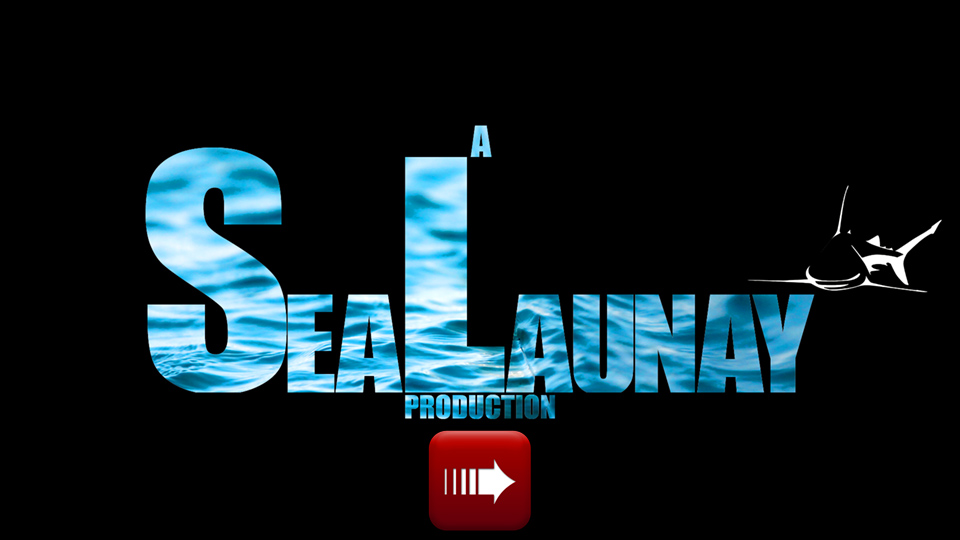
Thank you to every one for an incredible run, you rock my world and I sincerely wish you all the happiness and success that life can bring in 2013!
Video: http://bit.ly/1BRXZsI

Thank you to every one for an incredible run, you rock my world and I sincerely wish you all the happiness and success that life can bring in 2013!
Video: http://bit.ly/1BRXZsI
No Comments — Adventure / Aerial / Aquatic / Architecture / Circumnavigation / Design / Destination / Detail / Dinghy / Environment / History / In the Shed / Interior / Life Style / Massilia / Maxi Yacht / Monohull
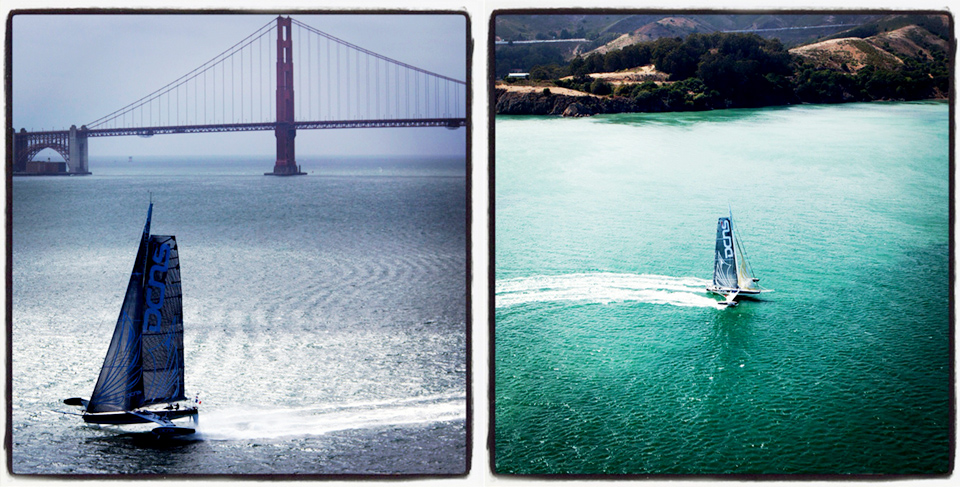
Photo assignment for l’Hydroptère.
Like a wild animal circling the territory waiting to pounce on it’s prey, l’Hydroptere DCNS is currently in San Francisco training on the Bay while they wait for the ideal weather window to attack the Transpac record from Los Angeles to Honolulu. These Northern California sessions have been extremely beneficial for the team and allowed Alain Thébault to share his incredible magic carpet with colleagues, media repesentatives, and members of the SF sailing community. These photos are some of our favorite from the past week, featuring guests such as America’s Cup luminaries Paul Cayard, CEO of Artemis Racing and Luna Rossa helmsman Paul Campbell James. Record setting kiteboarder Robbie Douglas has also been invited onboard for several runs, the only man to achieve a faster speed on the water than Alain and his team. With the way things are looking, the existing Transpac record has much to fear from the soaring wings of the mighty hydrofoil.
Words: Fred Eagle

No Comments — Adventure / Destination / Multihull / Performance / Sport / Yachting
 Photo assignment for Red Bull.
Photo assignment for Red Bull.
Aerial photo-shoot of l’Hydroptère DCNS Alain Thébault and his Dream Team (Yves Parlier, Jean le Cam, Jacques Vincent, Luc Alphand) during the first series of trials at La Ciotat in the Mediterranean.
The trimaran has now arrived by container ship in Los Angeles where she will be based whilst waiting for a weather for an attempt on the Pacific crossing record between Los Angeles and Honolulu this summer.

No Comments — Adventure / Design / History / Multihull / Performance / Racing / Record / Sport / Yachting
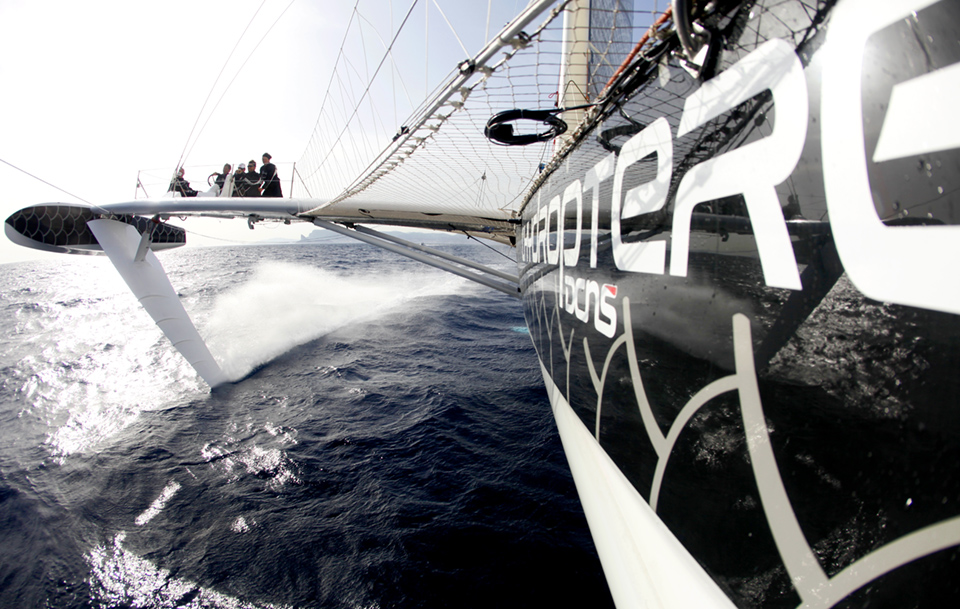 Photo assignment for Red Bull.
Photo assignment for Red Bull.
Onboard l’Hydroptère DCNS Alain Thébault and his Dream Team (Yves Parlier, Jean le Cam, Jacques Vincent, Luc Alphand) during the first series of trials on the Med before trying to beat the Pacific crossing record between Los Angeles and Honolulu this summer. La Ciotat in the Bouches-du-Rhône, Provence-Alpes-Côte d’Azur, France.
No Comments — Adventure / Design / History / Multihull / Onboard / Performance / Record / Sport / Yachting
Enjoy these photos from our visit to the legendary Hydroptère trimaran at her home in La Ciotat to have a look at her stylish & apropos ‘flying fish’ livery which began application on the main hulls over the winter season thanks to the creative design process by the agency Dragon Rouge. Always a unique and somewhat ominous experience to photograph a Hot Rod in waiting, you are able to feel the Hydroptère’s energy and capacity for flight even while she is resting on the hard
Within the next few weeks, the Hydroptère team will assemble the boat on the quay outside the H2X shed for an intensive logistical analysis and inspection routine to ready the boat for her inevitable great things to come. L’Hydroptère is to undergo an ambitious schedule, primarily the Transpac passage record attempt from Los Angeles to Honolulu, slated for June of 2012 and currently held by Olivier Kersauson and his crew of Geronimo, set in 2005.
L’Hydroptère is no stranger to speed records and is the proud holder of the outright speed record by a manned vessel at 51.36 knots for 500 meters (2010) and 50.17 knots for 1000 meters (2009). The only speed higher has been by achieved a kitesurfer at 55.65 knots, but we doubt that the men of L’Hydroptère have had their final say in the matter.
A very enthusiastic Alain Thébault, the skipper of the newly decorated flying fish, had this to say:
“I had a dream, I wanted to make a boat fly. In the US, everything is possible. I am impatient to share my flying carpet with American people.”
A magic flying carpet indeed, we look forward to your immediate future visit to the States and the continuation of the successful legacy of L’Hydroptère with an anticipatory ear to the water.
Words: Fred Eagle
No Comments — Adventure / Design / History / In the Shed / Multihull / Performance / Racing / Record / Sport / Yachting
No Comments — Adventure / Architecture / Design / Multihull / Racing / Record / Sport / Yachting
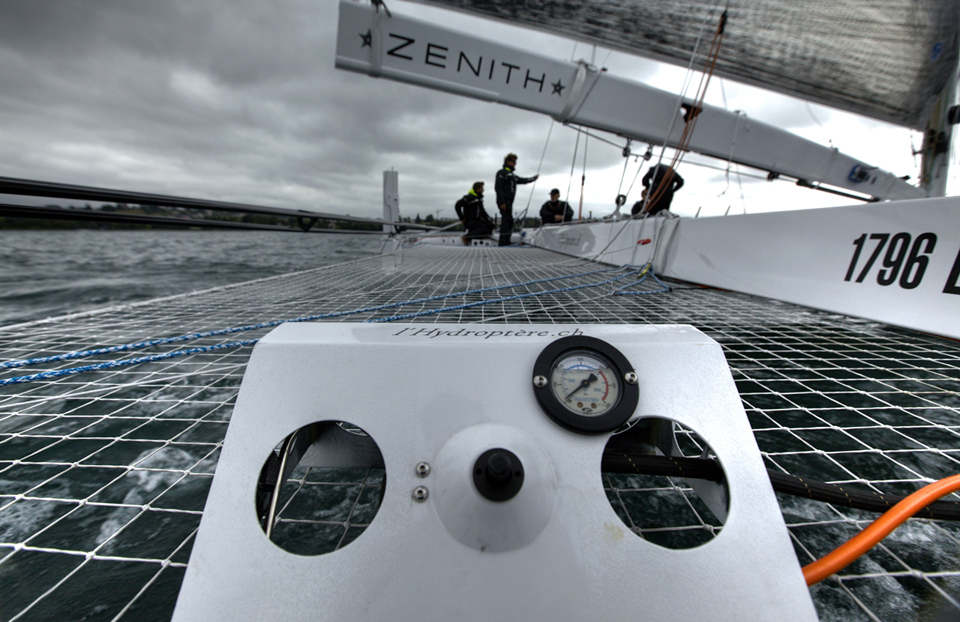 Hydroptere.ch embarks on her record breaking quest
Hydroptere.ch embarks on her record breaking quest
The Hydroptere.ch broke two records (records for the Lake Geneva or Lake Léman)
29.18 knots over 1 km and hit a peak speed of 34.84 knots, 1 of June 2011.
21.32 kts on a hour 2 of June 2011
Launched in autumn 2010, this catamaran is part of a complete scientific process. As a lab boat, her main purpose is to test geometries and behaviours in varied real conditions for the development of l’Hydroptère maxi, Lausanne, Switzerland.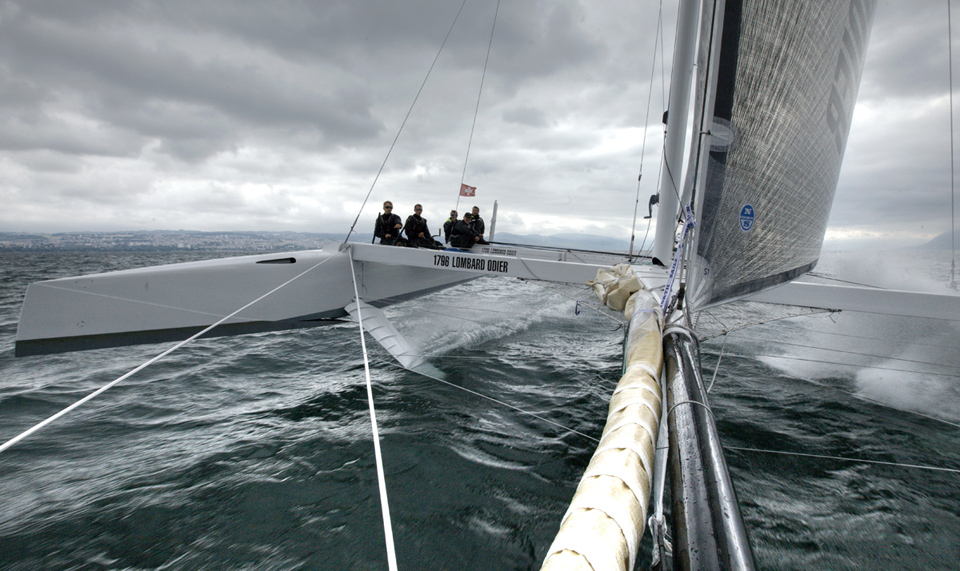
No Comments — Adventure / Architecture / Design / Multihull / Onboard / Performance / Racing / Record / Sport / Yachting
No Comments — Circumnavigation / Design / Destination / Multihull / Onboard / Performance / Record / Sport / Travel / Yachting
 Se voir proposer une navigation à bord de l’Hydroptère est déjà extraordinaire. Mais quand en plus c’est à l’occasion d’un convoyage entre Lorient et Cowes, c’est carrément dément! Récit d’une nav’ hallucinante – surtout de nuit !- jusqu’à l’île de Wight.
Se voir proposer une navigation à bord de l’Hydroptère est déjà extraordinaire. Mais quand en plus c’est à l’occasion d’un convoyage entre Lorient et Cowes, c’est carrément dément! Récit d’une nav’ hallucinante – surtout de nuit !- jusqu’à l’île de Wight.
(Non mais tu imagines leurs têtes !) Billy rigole. On essaye de se représenter la scène. Les hommes de quart à la passerelle de leur énorme cargo labourant la Manche à une vingtaine de noeuds. Le spot qui naît soudain sur leur écran radar. Sa progression rapide. Et leurs têtes, oui, en voyant une drôle d’araignée à voile, haut perchée sur l’eau, les dépassant à près de 30 noeuds !
Il faut le reconnaître : rallier Lorient à Cowes, île de Wight, à bord de l’Hydroptère d’Alain Thébault n’est pas une expérience comme les autres. Naviguer au large, passer le raz de Sein, sillonner la Manche et traverser la nuit noire à quatre mètres au-dessus de l’eau n’est vraiment pas banal, surtout à plus de 16 noeuds de moyenne…
Tout commence mi-mai, quand Jacques Vincent me demande si un convoyage à bord de l’Hydroptère me ferait plaisir. Moi, je suis photographe professionnel, j’aime la mer, j’adore la voile : la question ne se pose même pas ! Je réponds, oui, bien sûr, à peine intimidé à l’idée de naviguer sur le voilier le plus rapide du monde – 51,36 noeuds sur 500 mètres et 50,17 noeuds sur un mille.Au moment d’embarquer à Lorient, j’ai quand même le coeur qui bat. Pour moi, l’Hydroptère est un monstre, une engin de génie qui mêle tout, un bateau, un avion, avec des nageoires de baleine en guise de foils, deux grandes pattes d’araignée reliées par l’immense toile des trampolines, des flotteurs d’hydravion, un safran semblable à ceux des Moth à foils, mais en infiniment plus grand, l’intérieur monacal d’un sous-marin, un volant de voiture pour piloter – bref, une machine digne de l’imagination de Jules Verne.
(OK, Christophe, tu es prêt pour ton premier vol ?) me lance Jacques Vincent alors que nous venons juste de quitter Lorient. (Et comment !) Le tri-foiler accèlère doucement : 10 noeuds, 12 noeuds, les mouvements s’adoucissent peu à peu, une sensation différente commence à paraître, 15 noeuds, le bateau s’élève, monte, décolle – il vole, je vole!
Le bateau glisse avec une douceur incomparable, j’ai l’impression d’être dans un ascenseur qui évoluerait constamment, mais en souplesse, d’une façon fluide, entre le rez-de-chaussée et le premier étage d’un immeuble. Rien à voir avec un trimaran de course où l’on peut ressentir, avec la vitesse, le décollage du flotteur au vent puis celui de la coque centrale, tandis qu’il s’appuie sur le flotteur sous le vent avec l’aide de ses foils.
Jacques est au volant, Billy Besson au chariot de grand-voile, Gaël Ledoux au réglage du solent, James Bird au winch de grand-voile – et moi, je reste bouche bée…
Nous sommes partis pour 300 milles d’une navigation sous haute concentration. Si le bateau a tendance à partir au lof, il faut choquer le plus rapidement possible le chariot de GV et, en cas de début d’enfournement, il faut tout aussi vite libérer la voile d’avant…
Nos quarts s’installent sur le tapis volant – je passe au contrôle du chariot, puis au solent et de temps en temps au volant. Cette curieuse petite roue inclinée réclame une conduite intuitive – comme en avion j’imagine. Tout est affaire de souplesse et de réflexes. La barre est en tout cas très douce, réactive et précise – un régal. Et il est très difficile de quitter la (cabine de pilotage) ! Et puis, ce n’est pas tous les jours que j’ai l’opportunité de planer si près de mon élément préféré – j’en profite…
La nuit approche. L’instant est étonnant, d’autant que la météo joue les ruptures, entre molasse et vent établi. Je suis heureux de pouvoir capturer ce sujet sous une magnifique lune qui, de plus, simplifie la navigation et la lecture du plan d’eau, entre vagues et risées.
A l’intérieur, rien n’est bien sûr prévu pour notre (croisière) : pas de bannettes, pas de réchaud, pas de toilettes. Mon premier quart de repos a lieu dans la (capsule avant), minuscule espace situé juste avant le mât, entre les deux bras. Je dors à même le fond de la coque centrale, seul un fin tapis de mousse m’isolant du composite et de l’eau salée.
De chaque côté de mon corps, je peux ainsi sentir la compression imposée à la structure à chaque (touch and go) – c’est fou ce que ce bateau vrille et travaille. Mais quelle incroyable sensation de se reposer en vol, la surface de l’eau loin sous mon dos. Cela dit, comme toujours en multicoque et à bord des voiliers de performance, je dors les pieds en avant, car l’enfournement ou le coup de frein n’est jamais pas très loin.
Après des conditions de navigation instables et un arrêt technique à Brest, nous repartons au petit matin. La Manche est bientôt là. Cap au 70, direct sur l’entrée du Solent. Par un vent de 15 noeuds d’Est-Sud-Est, nous avalons les 150 milles en six heures à 25 noeuds de moyenne…
Après avoir coupé les rails des cargos, Cowes approche. James Bird est au volant lorsque nous passons les Needles, à l’Ouest de l’île de Wight, pour entrer dans le terrain de jeux de son enfance, le Solent. Comme souvent, l’arrivée est belle, mais triste – l’Hydroptère est un plaisir intense dont on devient très vite dépendant. Ce qui donne envie de lancer à son équipage, comme à la fin d’un voyage en avion : (J’espère très vite me revoir sur vos lignes !)
L’Hydroptère en quelques chiffres
Longueur : 18,28 mètres
Largeur : 24 mètres
Tirant d’eau : 3,50 mètres
Tirant d’eau en vol : 2 mètres
Voilure au près : 300 mètres carrés
Surface grand-voile : 195 mètres carrés
Surface solent : 105 mètres carrés
Surface trinquette : 65 mètres carrés
Longueur flotteur : 6,70 mètres
Longueur foils : 5,70 mètres
Poids en charge : 6,5 tonnes
Hauteur mât : 28 mètres
Records homologués
- 51,36 noeuds sur 500 mètres le 4 septembre 2009 à Hyères (record actuel établi le 28 octobre 2010 à Luderitz, Namibie, par le kitesurfer Rob Douglas avec 55,65 noeuds)
- 50,17 noeuds sur un mille le 8 novembre 2009, toujours à Hyères.
No Comments — Design / Multihull / Onboard / Performance / Record / Situation / Sport / Travel / Yachting
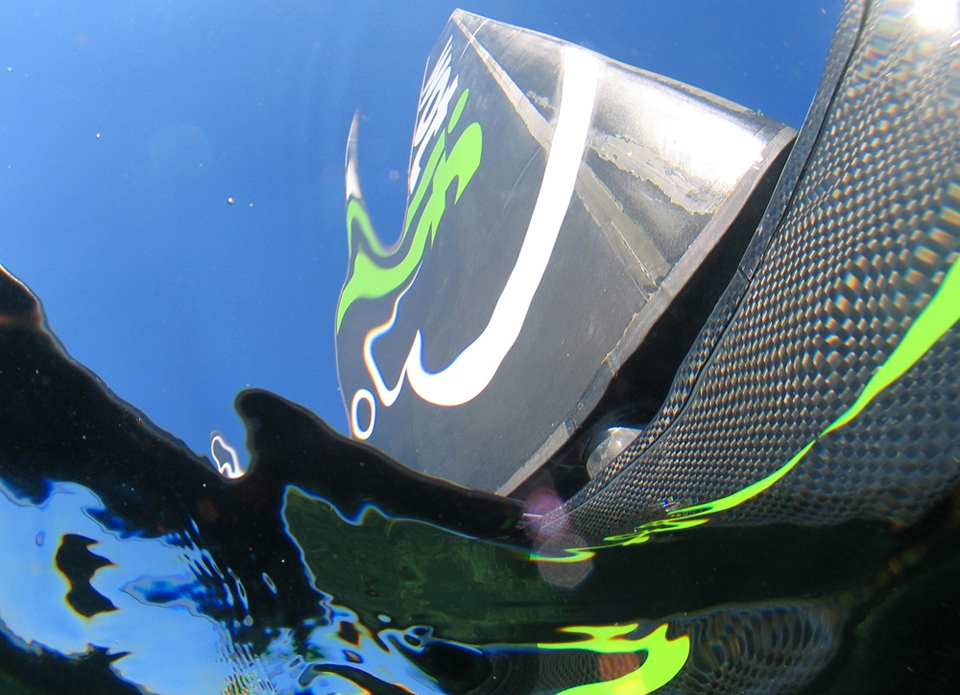 Australia’s attempt to reclaim the 500m world speed sailing record.
Australia’s attempt to reclaim the 500m world speed sailing record.
Pilot Sean Langman and co-pilot Joe Dekock testing the Wot Rocket for the world speed sailing record attempt at Belmont, Lake Macquarie.
The Wot Rocket is half sailboat/sail plane; a nine meter long canoe style hull with two tiny foils, each about a sixth of the size of a Moth foil and a nine meter rigid sail, then a traverse beam out of an aerodynamic twin pod crew compartment. It is built entirely from carbon fiber and weighs approximately 400 kilos.The difference between this sailboat/sail plane and any that have come before it is that it will be attempting to break through the water speed barrier using a technology as yet untried on any sailing craft – supercavitation – to reduce the drag which is around 1,000 times greater in the water than in air.
Supercavitation will in effect mean Wot Rocket flies in a gas bubble created by the outward deflection of water by a specially shaped nose cone and the expansion of gases from its fin and foil design. By keeping water from contacting the surface of the body of Wot Rocket, this will significantly reduce drag and allow extremely high speeds.
The concept behind the Wot Rocket approach is to induce supercavitation at lower speeds where control can still be maintained and from there push through to the top speeds.Supercavitation means Wot Rocket should only require a fraction of the 45-50 knot winds that Albeau needed to go 0.39 knots better than the previous record. A moderate 18-20 knots should do the trick believes Langman.
No Comments — Design / Multihull / Performance / Record / Sport / Yachting